Posted: June 20th, 2014 | No Comments »
An interesting addition to the literature on early RoC Taiwan….
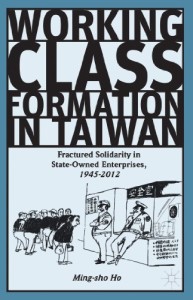 Ming-sho Ho applies Marxist theoretical perspective to understand the postwar trajectory of Taiwan’s state-sector workers. A global and comparative framework is used to examine the particularity of Taiwan’s working class. It revises the stereotypical image of labor docility by showing ethnicity, party-state, and internal labor market produces intra-class divides and generates a variety of workers’ resistance even under the repressive rule of one-party authoritarianism. The book looks at the rise of independent labor movement in the wake of political liberalization in the late 1980s. The similar current of social movement unionism of South Africa, South Korea and Brazil is also present in this oft-neglected case. Ho observes how labor activism gradually resides as democracy is consolidated and neo-liberalism becomes the new ideological hegemony.
Ming-sho Ho applies Marxist theoretical perspective to understand the postwar trajectory of Taiwan’s state-sector workers. A global and comparative framework is used to examine the particularity of Taiwan’s working class. It revises the stereotypical image of labor docility by showing ethnicity, party-state, and internal labor market produces intra-class divides and generates a variety of workers’ resistance even under the repressive rule of one-party authoritarianism. The book looks at the rise of independent labor movement in the wake of political liberalization in the late 1980s. The similar current of social movement unionism of South Africa, South Korea and Brazil is also present in this oft-neglected case. Ho observes how labor activism gradually resides as democracy is consolidated and neo-liberalism becomes the new ideological hegemony.
Posted: June 19th, 2014 | No Comments »
RASÂ WEEKENDERÂ Â
Saturday 21 June
 4:00 PM for 4:15 PM at
 The Apartment, 47 Yongfu Lu, near Fuxing Xi Lu
 
LINDA JOHNSON
 on
Shanghai on Film: the Epic Films of the
Postwar Period, 1945-1949
1946 is one of those moments in Chinese film history when the industry had to reflect upon its role as mass media and the position it would take on the social situation in Shanghai. This was a moment defined not simply by leftist or rightist political affiliations, but by the voice filmmakers would raise on the social issues of the day. They were fuelled not by the imperatives of some national political agenda, but by their own experiences and by the cultural constraints of an industry situated by time, place and its own history. This was an industry of mass media, configured by the co-existence of private and state-run film companies that recognised the power of film to impact behaviour.
Just as 1931 had witnessed a wave of more patriotic film making, 1946 saw a localised form of patriotism in which the people of Shanghai and their particular experience of Japanese occupation were the target audience. The epic films of the period give expression to a particular historical moment in Shanghai’s story and offer insights into Shanghai’s film world poised on the brink of its next era.
The films Dr Johnson will examine in this period are about film culture; they create an interplay between fiction and reality by taking a romance and investing it with the real life struggles of Shanghai and the embedded real life stories of the actors and the filmmakers, known to the audience through the production of the star system circulated by a prolific print media. They both give recognition of the hardships of the postwar period and challenge their audience to produce a solution.
Dr Linda Johnson first came to China in 1986 as a Law Lecturer, working in the Law Faculty at Hong Kong University until 1995 when she moved back to London. In 1998 she came to live in Shanghai with her husband and three daughters, opening Madame Mao’s Dowry in 2001, a concept design store specialising in art and artifacts of the Mao Period. Her interest in Chinese film began in Hong Kong in the 1980’s and has been growing ever since. Linda was invited to act as convener for the RAS Film Club in September 2011. She regularly gives talks on both Mao Period propaganda and Shanghai film.
Talk Cost: RMB 70.00 for members, RMB 100 for non-members. Includes glass of wine or soft drink.
Membership applications and membership renewals will be available at this event. Those unable to make the donation but wishing to attend may contact us for exemption.
RAS Monographs: Series 1 & 2 will be available for sale at this event. RMB 100 each (cash sale only).
 To RSVP: Please “Reply” to this email or write to
 RAS Bookings at: bookings@royalasiaticsociety.org.cn
Posted: June 18th, 2014 | No Comments »
In 1900 Macao’s brothels were generally dirty and run by notoriously rough Eurasian pimps and Lisbon Madams who were known for hooking the girls on opium and for importing kidnapped or trafficked young Portuguese girls. The Rua de Felicidade (suitably named Happiness Street in English) was a narrow lane where every house was thought to be a bordello. The street was close to the historic centre of the enclave near the otherwise respectable Lenal Senado square where the better class of Europeans in Macao took their evening promenades.
Today, Rua de Felicidade is a touristy shopping street (within the UNESCO World Heritage site of Macao) with a few shophouses with traditional red louvers left. Those who watch Hollywood films may recognize the street from Indiana Jones and the Temple of the Doom.

Posted: June 17th, 2014 | No Comments »
Shanghai based journalist Mara Hvistendahl has done a solid job of work reconstructing the events around the 2008 murder of the Canadian model Diana O’Brien in her new e-book And the City Swallowed Them… Hvistendahl’s retelling of the horrific murder, the seedy underbelly of the Chinese modelling business, the police investigation and the underlying tensions in Shanghai on the eve of the 2008 Olympics is excellently done and revealing (as someone living a stone’s throw from the murder scene in 2008 all that permeated out was rumour and supposition at the time).

At age 22, Diana O’Brien left a small island community on Canada’s Pacific Coast and moved to China to work as a model. Twelve days later, she was stabbed in a Shanghai stairwell. The actions of both police investigators and O’Brien’s Chinese modeling agent soon aroused suspicion as her family sought answers from China’s opaque legal system. Ultimately, their quest would put them face to face with her accused killer.
At once a page-turning murder mystery and a work of deep investigation, And The City Swallowed Them is a true crime nonfiction story based on dozens of interviews with investigators, models, and both the victim’s and the convicted murderer’s families. The short book moves from Shanghai’s back alleys to the seedy underbelly of high fashion, where young models travel alone to strange cities, often with falsified work papers, and sleep ten to an apartment between cover shoots. Set against the backdrop of Shanghai’s explosive urbanization, the work also explores the world of China’s liudong renkou, or floating population, where the hopes of newcomers from poor villages often turn to dust—leading some to horribly desperate acts.
The debut digital title from the writers cooperative Deca, And The City Swallowed Them overturns assumptions about both China’s feared justice system, where the conviction rate for criminals is 99.9 percent, and the glamorous world of international modeling. More than a murder tale, And The City Swallowed Them lays bare the powerful forces that send two families on a collision course from distant sides of the Pacific.
Posted: June 16th, 2014 | No Comments »
I first blogged about 81 Chaonei Dajie back in 2008 and have done so occasionally ever since as new rumours surface as to the Beijing buildings future. Frankly I’m amazed the French baroque style buildings are still there!! In Shanghai they would have either gone by now or become a bar, but Beijing’s record is far more awful and that they’re still standing, even in their current rather untended and decrepit state is something close to a miracle. Fitting perhaps as the buildings were the former missionary language training school. There have also been rumours about some French train magnate owning the buildings but I know of no solid evidence of that. Another erroneous tale has been circulating that the buildings were formerly the USSR Embassy pre-1949 but that’s nonsense too. Certainly the property is now controlled by the Beijing Catholic Diocese but they have not proved to ever be great lovers of preservation.
And so now Shanghaiist reports more rumours about renovation plans – rumours that have periodically cropped up every six months or so for years now. And while it is true that No.81 has a preservation order applied to it this, as regular China Rhyming readers will know, effectively means nothing as this blog is packed full of Shanghai and Beijing properties with preservation orders who were bulldozed at 3am to make way for a shopping mall.
Maybe this time something will happen. As the insides have largely been gutted already and partially open to the elements for a decade or more now there is probably little left to salvage inside but it is to be hoped that any “restoration plan” doesn’t involve knocking the whole thing down and rebuilding it in a sort of similar style! A Beijing developer tactic we’re all familiar with time and again.

Posted: June 15th, 2014 | No Comments »
I blogged recently on the discovery of some rather lovely Chinese wallpaper at Woburn Abbey. Woburn is not a National Trust property but, apparently, many NT houses do have excellent examples of Chinese wallpaper and not the Trust has gathered together all these locations in one delightful book, Chinese Wallpaper in National Trust Houses….
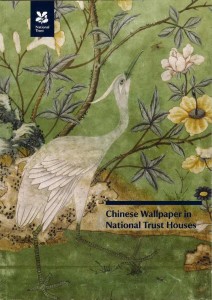
The enduring popularity of Chinese wallpaper in the west is an astonishing phenomenon. A fragile, exotic luxury product, it became fashionable from Ireland to Russia and from Sweden to Italy. Its imagery was consistently misunderstood, but its visual impact proudly affected the development of European and American interiors.
Format: Paperback.
Extent: 48 pages including photographs.
Dimensions: book measures approx: 29.5cm H x 21cm W x 0.5cm D.
ISBN: 9780707804286
Posted: June 14th, 2014 | No Comments »
Marc Chadourne was a French writer (and Prix Goncourt winner), adventurer and spy of sorts who visited China several times in the 1930s. He also visited Russia, Singapore, Calcutta and Tokyo to have a poke about. His earliest trip yielded the book Chine (China) which was popular enough to go into a 20,000 print run initially. “Smiling chaos and prosperous disorder” were his general impressions. In what could be an echo of writing on China today Chadbourne wrote, “The Chinese wall is alive. Each Chinese builds it within and about himself. It explains and illustrates China. It is at once her spirit and her history, her protective organism and growth, the living symbol of her offensive and defensive strategy, of her struggle inch by inch against the Occident.” Hard to find but worth a read….and here’s a long and thoughtful contemporary review by Lucille Douglas (an illustrator who knew China well) in The Saturday Review of Literature from 1932.
Incidentally, Chadourne returned to China in 1939 on a mission for French intelligence and the French Colonial Ministry to describe China, and Shanghai particularly, as infested with spies, charlatans and crooks. You could write that today too!
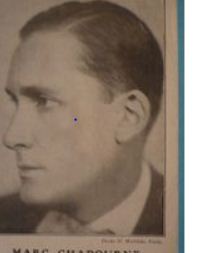 Marc Chadourne
Marc Chadourne
 The French edition
The French edition
 the Italian edition for contrasting cover styles
the Italian edition for contrasting cover styles
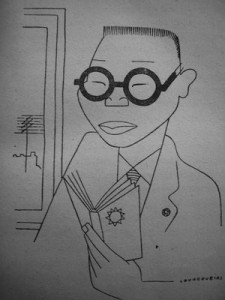 the book is illustrated throughout by the Mexican artist Miguel Covarrubias
the book is illustrated throughout by the Mexican artist Miguel Covarrubias
Â
Posted: June 13th, 2014 | No Comments »
RAS STUDIO
Â
Tuesday 15th July 2014 at 7:00 pm for 7:15pm
Venue: TBC
Â
ROBIN LUNG
“Finding Kukanâ€
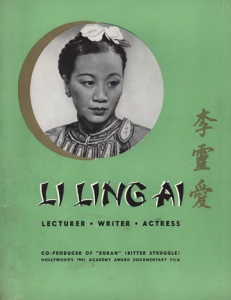
In this RAS Studio event, documentary maker Robin Lung will talk about her forthcoming film ‘Finding Kukan’.
A reflection on lost history and the power of art, this feature documentary follows a filmmaker’s quest to bring recognition to the unheralded woman behind the making of KUKAN, a long-lost Academy Award-winning colour documentary about World War II China.
Asian Americans have been a part of American history and culture for many generations, yet the term “Asian American Hero†is still an oxymoron in mainstream media and popular culture. In Finding KUKAN, Hawaii filmmaker Robin Lung embarks on an investigative journey to reclaim a Chinese American heroine from the past. At a time when Chinese Americans were denied basic rights of citizenship, Li Ling-Ai was a pioneering playwright and moviemaker. She was the un-credited producer of KUKAN, a 1941 colour film about World War II China, and one of the first documentaries to receive an Academy Award. Why have we never heard of Li Ling-Ai or KUKAN? And why have all copies of KUKAN vanished completely? These questions become deeply personal as Robin learns that the socio-political forces that robbed Ling-Ai of credit and caused KUKAN to go missing have shaped her own viewpoint in profound ways. Prior to producing KUKAN, Li Ling-Ai knew little about making movies and director Rey Scott had never held a motion picture camera in his hands. They had no Hollywood backing or government support. Yet they created an epic colour film of China that screened for President Roosevelt at the White House and had long runs in theatres across the country. Robin looks beyond the entrancing Cinderella story of KUKAN to ask why the Academy Award and most of the credit was given to Rey Scott. Were Li Ling-Ai’s achievements overlooked because she was a Chinese woman?
About the Speaker
Robin Lung is a 4th generation Chinese American who was raised in Hawaii. She has been producing short films and documentaries for the past ten years.  A graduate of Stanford University and Hunter College in NYC, Lung made her directorial debut with Washington Place: Hawai‘i’s First Home, a 30-minute documentary for PBS Hawai‘i about Hawai‘i’s historic governor’s mansion and home of Queen Lili‘uokalani (aired December 2008). She was the Associate Producer for the national PBS documentary Patsy Mink: Ahead of the Majority (aired October 2008) and the Hawai‘i Unit Producer for the 2011 Venice Film Festival opening night film Vivan Las Antipodas! She was the producer/director for numerous short documentaries for the Historic Hawai‘i Foundation.  As a filmmaker she is driven by a desire to preserve the stories of extraordinary people from minority backgrounds who are often overlooked by mainstream media.
 http://findingKUKAN.com
RAS Studio – Entrance: RMB 70 (RAS Members) and RMB 100 (non-members) including a drink (soft drink or glass of wine).
Those unable to make the donation but wishing to attend may contact us for exemption, prior to this event. Member applications and membership renewals will be available.
 Ming-sho Ho applies Marxist theoretical perspective to understand the postwar trajectory of Taiwan’s state-sector workers. A global and comparative framework is used to examine the particularity of Taiwan’s working class. It revises the stereotypical image of labor docility by showing ethnicity, party-state, and internal labor market produces intra-class divides and generates a variety of workers’ resistance even under the repressive rule of one-party authoritarianism. The book looks at the rise of independent labor movement in the wake of political liberalization in the late 1980s. The similar current of social movement unionism of South Africa, South Korea and Brazil is also present in this oft-neglected case. Ho observes how labor activism gradually resides as democracy is consolidated and neo-liberalism becomes the new ideological hegemony.
Ming-sho Ho applies Marxist theoretical perspective to understand the postwar trajectory of Taiwan’s state-sector workers. A global and comparative framework is used to examine the particularity of Taiwan’s working class. It revises the stereotypical image of labor docility by showing ethnicity, party-state, and internal labor market produces intra-class divides and generates a variety of workers’ resistance even under the repressive rule of one-party authoritarianism. The book looks at the rise of independent labor movement in the wake of political liberalization in the late 1980s. The similar current of social movement unionism of South Africa, South Korea and Brazil is also present in this oft-neglected case. Ho observes how labor activism gradually resides as democracy is consolidated and neo-liberalism becomes the new ideological hegemony.








